
London’s World Travel Market is a window into the heart of the global tourism industry. This year, the Caspian Region was better represented than ever before.
All images by Mark Elliott
Meeting annually in London, the World Travel Market (WTM) is one of the planet’s most important trade fairs for the global tourism industry. Essentially, it’s a chance for countries, service providers and national tourism brands to open a ‘shop window’ for travel professionals. It’s also a fundamental way the industry shares ideas – with a particular emphasis on sustainability and eco-friendly travel that makes sense given that the fair coincides almost exactly with the United Nations’ Conference of the Parties (COP27) at Sharm EL Sheikh.
As in 2021, the single biggest presence this year was that of Saudi Arabia, a country whose relatively sudden opening to international visitors in 2019 signals a very radical change from decades of being essentially closed to non-Islamic tourists. For countries of the Caspian Region, however, WTM 2022 couldn’t have been more different than WTM 2021. Last year a rather hidden Uzbek stand and a single travel firm from Armenia were essentially the region’s only representatives. In contrast, most nations were back in force this year, suggesting a major refocusing on tourism across the region.
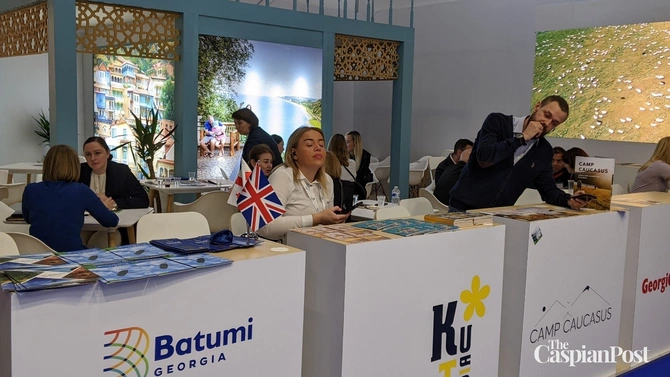
For Georgian tourism, there was a host of accolades. The Georgian port-resort city of Batumi featured particularly prominently with a major spread in the WTM Yearbook, celebrating its World Travel Award as Europe’s leading “emerging tourism destination” of 2022. Georgia also took gold in the same category at the parallel Wanderlust Travel Awards, hosted off-site in a very special venue: the Tower of London.
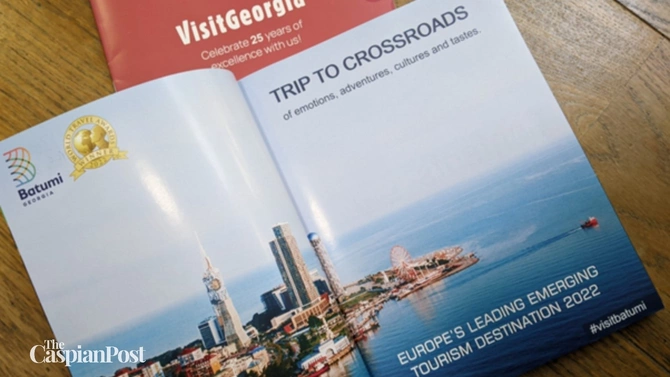
At WTM, Georgia had two different stands. One specifically showcased the incoming travel agency Visit Georgia, this year celebrating its 25th year. Another stand, acting as an umbrella for a series of Georgian Tourism companies, was keen to underline the country’s credentials as a food and wine destination and a place for winter sports and history.
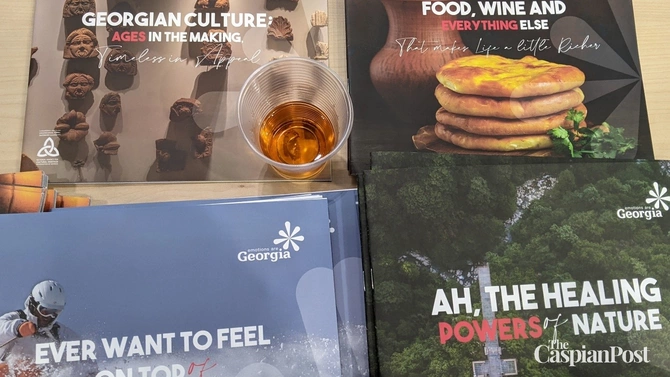
Georgia was the first country in the region to reopen to tourism in the period after the 2020-21 COVID lockdowns and has been seeing a significant surge in tourism – albeit much of that from Russia, as we have previously reported. Georgia’s authorities are now keen to rebalance the country’s tourism towards Western European visitors – a sector which had been fast-growing until 2020.
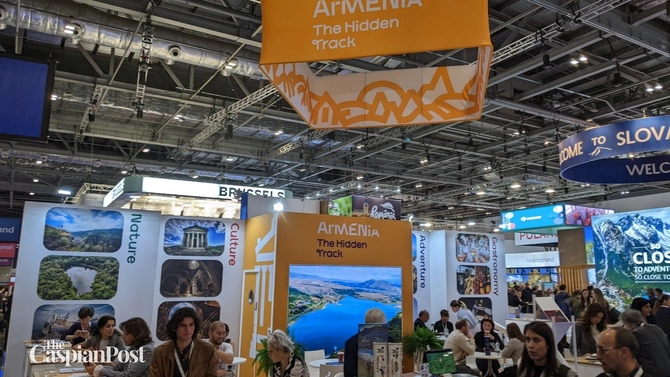
In contrast to last year, tourist maps being distributed by the Armenian stand at WTM this year made no reference to the formerly occupied areas of Karabakh.
For Armenia, this was the first WTM since the May 2022 relaunch of the national tourism ‘brand’ under the strapline “The Hidden Track.” Armenia’s London stand pointed visitors to the country’s long history of winemaking and potential for wine tourists, as well as suggested itineraries for multi-stop adventure trips combined with Georgia. What about including Azerbaijan too? No problem, suggested Lolita Hakobyan from very experienced Armenia Holidays, advising such travellers to start in Baku and work westwards rather than vice versa due to the partial border closure between Azerbaijan and Georgia (open westbound but closed eastbound at the time of writing).
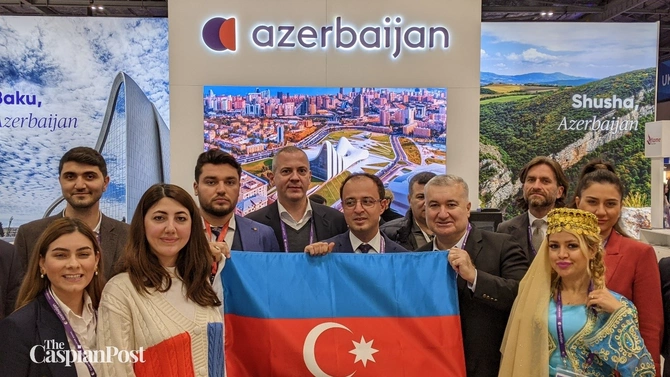
Of the Caucasus stands, that of Azerbaijan was arguably the most polished. The country’s stylish ‘Take Another Look’ branding continued to attract attention, and the promotional video “Azerbaijan – Where Culture Meets Adventure” was placed well within the top ten national


As part of his very busy WTM schedule, Azerbaijan Tourism Board CEO Florian Sengstschmid sat down to an interview with CNN’s Richard Quest
Azerbaijan’s expansive WTM stand included sub-desks for a whole series of service providers - including representatives of PMD Hospitality, a growing hotel chain focused on spa wellness and medicinal getaways. Their snazzy portfolio includes no less than three luxury properties specializing in Naftalan oil bath treatments: yes, soaking yourself in a special kind of healthy petroleum.

Tajikistan’s appearance at WTM seems to underline the country’s newfound commitment to developing tourism. As outlined in its recent master plan, the country accepts that it still has a lot to do to raise awareness of its magnificent range of visitor possibilities, both culturally and in terms of sustainable adventure travel. Relaxed new e-visa options should help, and Khudoguy Shonazarov from Dushanbe’s Roof of the World Travel underlined the particular delights of the spectacular Pamir mountain area in the country’s southeast, where soaring peaks rise to over 7000m.

Better established as a Central Asian tourism destination, Uzbekistan’s stand this year was an uplifting affair celebrating the colours and flavours of the country’s archetypal Silk Route cities. The national focus on boosting tourism continues to intensify with an increased frequency of direct flights from London to Tashkent, a glorious new terminal at Samarkand International Airport and, notably, the Silk Road Tourism Complex in the capital. Opening in September, it will help build on Samarkand’s world-famous Registan to cement the city’s status as the hub of Central Asian tourism. Meanwhile, the country maintains a varied portfolio of alternative attractions, from the off-beat electronica festival Stihia, to developing spiritual tourism, as illustrated by the regeneration of the tomb of Imam al-Bukhari this year.

The Kazakhstan stand was just one of the national representations to feature local musicians.
In the 1990s, the magical, primarily mountainous republic of Kyrgyzstan was one of the first ex-Soviet states to open up to tourism, and it retains a relaxed visa-free entry system for over 60 nationalities. The general approach has long concentrated on small-scale community-based travel initiatives. However, a lot more is on the horizon.

Amid a constellation of WTM fringe events, Kyrgyzstan hosted a fascinating presentation in a Bayswater hotel pinpointing a whole raft of proposed infrastructure mega-projects. Amongst these are the US$280 million rehabilitation of over 30 sanatoria into wellness centres, a US$62 million sports complex at Tamga (Issyk Kul), US$101 million of new ski resort infrastructure at Oruu-Sai and a ‘nomad universe’ centre. The most impressive projects of all are two resort city regenerations together budgeted at around US$1 billion – one at Karakol (already a tourism hub at the eastern end of Lake Issyk Kul), the other, more daringly, at Razakov – a somewhat obscure town in the southwest, known till recently as Isfana.
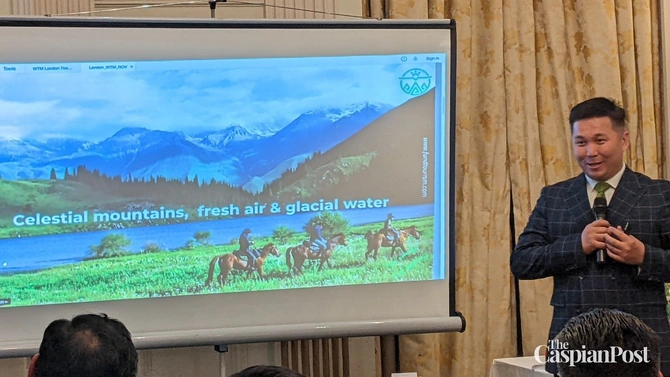
At a WTM fringe event, Kairat Itibaev of Kyrgyzstan’s Tourism Development Support Fund outlined a spectacularly ambitious wish list of investments totalling nearly US$2 billion.
All across the Caspian Region, despite COVID aftershocks, conflict, ecological worries and economic downturns, a visit to WTM makes it clear that tourism remains very much part of the road map for the region’s future prosperity.
Share on social media